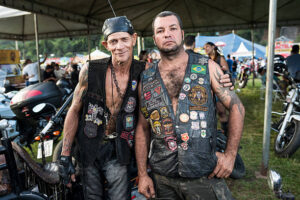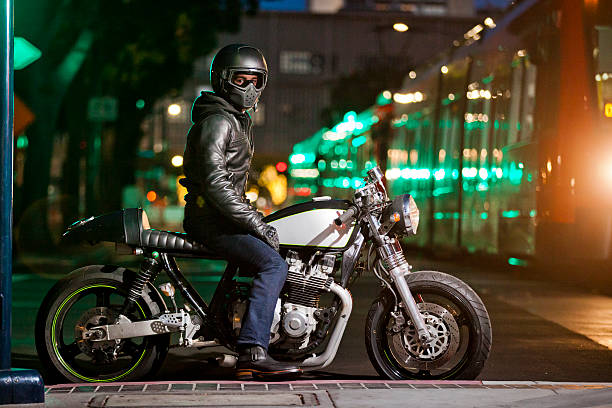The Meaning of the best leather biker vest Cuts in Motorcycle Culture
Motorcycle enthusiasts see leather biker vest cuts as an ethos, an assertion of character, and an image of the fellowship and sisterhood of two wheels. After The Second Great War, veterans needed the brotherhood and adrenaline of administration, which prompted leather cuts. The leather cut represented motorcycle thrills.

Many people confuse leather cuts with “leather jackets,” but they differ in construction and connotation. A classic cut is a sleeveless leather vest with patches, insignias, and personal souvenirs. These stories are as varied as the riders, including adventure, sorrow, camaraderie, individual accomplishments, and motorcycle club affiliations.
Leather cutting is a tactile and durable experience. The cut’s durability and rider protection depends on the leather—cowhide, buffalo, or horsehide. Cowhide, which resists abrasion and wind, is a popular choice for comfort and safety. Leather thickness, measured in ounces, adds another layer of customization, with heavier leathers giving more protection and lighter ones allowing more flexibility and comfort on lengthy rides.
Leather cutting is as unique as the patches. Many riders start with a pre-made vest and add patches, while others choose a fully personalized item that fits their physique and style. Customization goes beyond fit and leather; zippers, snaps, and lining represent the rider’s personality and needs.
Leather cuts revolve around patches and club colors. They express the rider’s story, associations, and ideals through visual language, not just ornamentation. The top rocker usually shows the club’s name or country/state, while the bottom rocker may represent the chapter’s location. The center patch is often the club’s badge, symbolizing the rider’s loyalty. Personal patches can honor dead cyclists, rally patches, or philosophical or humorous messages.
Leather cuts symbolize independence, respect, commitment, and the never-ending search for adventure, which define motorcycle culture. This tradition has grown to include riders from different backgrounds, each with their own tale to share. Women motorcyclists, formerly rare in motorcycle culture, now proudly display their cuts, enriching the community.
Those who wear leather cuts face many misconceptions. Bikers with leather vests might intimidate the uninformed, a reputation reinforced by media portrayals. Under the leather and patches is a community based on respect, compassion, and loyalty. Motorcycle clubs, many of which wear distinctive cuts, often fundraise for local organizations and help veterans and their families.
Leather cuts have changed with motorcycle culture, adjusting to new trends, technologies, and societal shifts while staying true to their roots. Thanks to synthetic materials, riders now have better weatherproofing and protection. Many like leather because of its natural features and patina, which symbolizes the rider’s trip.
Finally, The Leather Cut is a story about the routes traveled, the hardships faced, and the brothers and sisterhood created on the voyage. It symbolizes the biker community’s enduring spirit and its values and stories. As biker culture evolves, the leather cut will remain a key symbol of identity, freedom, and everlasting road ties.

Ride Soul: Leather Biker Cuts and Motorcycle Heritage
Motorcycle culture uses leather cuts as canvases to tell stories of freedom, fraternity, and the path less traveled. This famous vest, stripped of sleeves and typically embroidered with patches, is a badge of honor for motorcyclists, symbolizing their experiences, loyalty, and open-road attitude.
Leather cuts began in the aftermath of World War II when veterans sought consolation and excitement in two wheels, quickly beyond their original purpose. They represented resilience and defiance against post-war civilization. Each cut is decorated differently, telling the story of personal successes, losses, and deep friendships established under engine noise.
A leather cut is personal, depending on the leather—cowhide, buffalo, or horsehide. Like the riders, these materials are chosen for their toughness and waterproofness. The cut’s usefulness and style depend on leather thickness, pocket arrangement, and linings. However, the patches give it character.
Each patch on a leather cut is a message, tale, or memory carved in fabric, representing motorcycling culture. These patches, from club logos to commemorative badges, show the rider’s affiliations, accomplishments, and roads traveled. These patches—often governed by unwritten codes—tell a story of respect, loyalty, and the motorcycling community’s spirit.
Leather cuts are declarations. It announces a rider’s presence, commitment to the lifestyle, and place in motorcycle history. This garment protects against the weather and expresses individuality in a world that promotes uniformity above character.
Leather cuts affect more than just the individual. They represent the diverse and developing biker brotherhood that values freedom, daring, and mutual respect. Motorcycle clubs, typically at the center of this culture, proudly wear their cuts to show their identity and dedication to brotherhood and togetherness. With their rich traditions and rituals, these clubs organize rides, rallies, and philanthropic events to strengthen their bonds and links to the motorcycle community.
The world of leather cutting has misconceptions. The uninitiated may associate a gang of horsemen in leather and patches with outlaw rebels, a media cliché. Below the surface is a community based on honor, philanthropy, and everlasting loyalty.
As motorcycle culture grows, the leather cut evolves but retains its meaning. Riders have more protection and versatility because of new materials and technologies. However, leather remains popular due to its durability and unique patina.

The leather cut is a living history of motorcycle culture, with each stitch a reminder of the trips and connections made. It represents the motorcycle community’s undying spirit and the history of riders who paved the path for future generations.
Leather cuts represent the freedom of the wide road, the camaraderie of fellow riders, and the adventure at the core of motorcycle culture. As this culture evolves, the leather cut will remain a cornerstone, symbolizing individuality, tradition, and the eternal tie between rider and route.
The leather cut symbolizes freedom and companionship on the open road as motorcycle culture and its participants have changed. This biker icon embodies the ideals, traditions, and stories that bind riders throughout generations. As motorcycle technology evolves and society changes, the leather cut remains a symbol of solidarity, resilience, and personal expression. It not only protects against the elements but also symbolizes the biker culture’s camaraderie, adventure, and respect. The leather cut captures the ageless character of the ride, guaranteeing that the legacy of the road warriors who came before continues to inspire those who follow, igniting the biker community’s devotion.





Leave a Reply